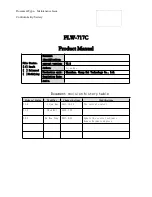
46
•
Camera Performance and Features
HDR Demo Mode
In planar mode, the camera can be configured to output sensor row 0 and 1 separately. Under the
same conditions, the row 1 is 4x more responsive than the row 0. The contrast ratio does not
always have to be 4:1, it can be varied depending on the contrast of the object. The user can
change the ratio by changing the exposure time and/or gain. Two different responsivities give two
different intensity images in a single scan.
In conjunction with the user’s algorithm
s, a High
Dynamic Range (HDR) image can be created based on the two images. This merging process is
called fusing. The goal of fusing is to replace all low contrast parts with the bright image
accordingly and replace all saturated or near saturated parts with the dark image accordingly.
Simple replacement, however, does not generate a seamless image, which we desire. In order to
get an image which dark parts are enhanced, but no saturations occur, and which is fused
seamlessly, an algorithm needs to be applied.
Ideal curve
Represents
dark image
Represents
bright image
Image Intensity
DN
Max swing
Represents
fused image
The HDR Demo mode demonstrates HDR imaging with a simple fusing algorithm,
y = ax + b (1-x),
where 0<x<1, a and b represent dark and bright images, respectively.
The gray curve in above graph represents this
algorithm’s result. The resul
t is moderate, yet not
perfect.
The user can develop their own algorithm to better suit their applications’ requirements.
The following is a banknote example, which fused with x=.5 in above algorithm.
Summary of Contents for ML-FM-16K07A
Page 17: ...Linea ML Multiline Monochrome HDR CMOS Cameras 17 Figure 8 Linea ML FM 16K Camera Mechanical ...
Page 18: ...18 Linea ML Multiline Monochrome HDR CMOS Cameras Figure 9 Linea ML HM 16K Camera Mechanical ...
Page 19: ...Linea ML Multiline Monochrome HDR CMOS Cameras 19 Figure 10 ML HM 08K camera mechanical ...
















































